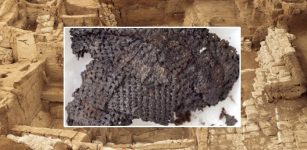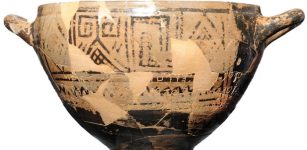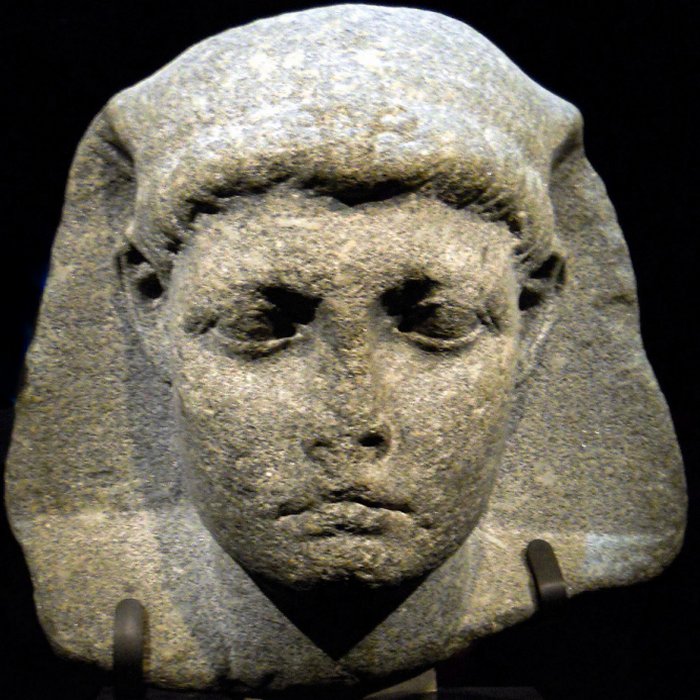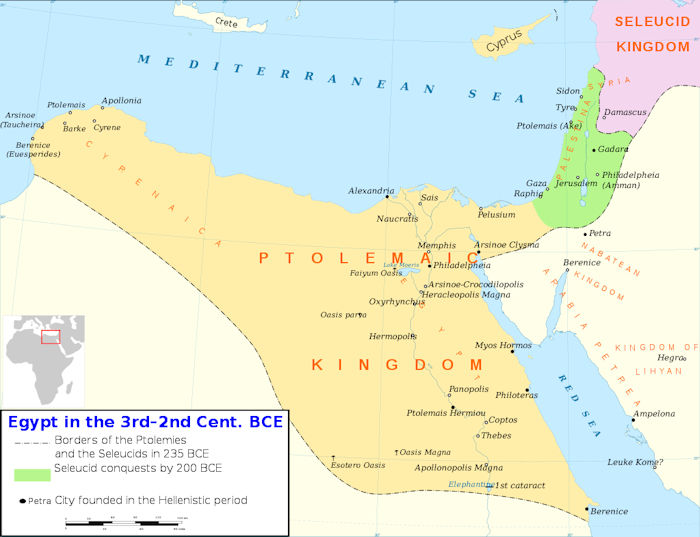‘Little Caesar’: Forgotten ‘King Of Kings’ Who Died Very Young
A. Sutherland - AncientPages.com - Caesarion was murdered on August 23, 30 B.C., only 17 years old. He was the last King of the Egyptian Ptolemies, most probably the son of Julius Caesar, and his mother was Cleopatra VII.
Caesarion was born in 47 B.C. in Egypt.
It is not certain, but commonly thought that the Roman leader was actually his father. If he really was a child of Caesar, it was also his only son.
No documentation has been discovered about his death; because of his young age, it is believed that he died of strangulation. Credit: Sdwelch1031 - CC0
Caesarion was said to have inherited Caesar's appearance and manner, and he was even allowed to use his name, but Caesar never officially acknowledged the boy.
In 46 - 44 B.C., he stayed with his mother in Rome. After the murder of Caesar by conspirators in 44 BC, Cleopatra and Caesarion returned to Egypt.
The three-year boy Ptolemy XV was proclaimed "King of Kings" and reigned jointly with his mother from September 2, 44 B.C.
He wasn't aware of the power struggles around him and his mother. Some powerful men wanted even more power; among them was Mark Antony, his mother's lover, and a Roman General and Julius Caesar's second cousin. The next one was the aristocratic Marcus Lepidus, who was earlier Caesar's, a close ally.
Ptolemaic Egypt was a culturally and intellectually lively place. Amphipolis - CC BY-SA 4.0
Then, there was Octavian; his claim to power proceeded from his status as Caesar's adoptive son. He did not like that Mark Antony gave Caesarion numerous titles (including 'King of kings') and possessions in the east when Antony officially announced that Caesarion was a true son of Caesar.
Octavian had a lot of support because Caesar's adopted son was considered his rightful heir. However, the whole situation began to worsen more and more because his political position was threatened.
The conflict between Octavian and Antony resulted in the Battle of Actium. On the morning of September 2, 31 B.C. the fleets of Roman Mark Antony and Cleopatra, queen of Egypt, met the fleet of Octavian leader just outside the Gulf of Actium in Greece.
A relief of Cleopatra VII and Caesarion at the temple of Dendera, Egypt. Credit: Rowan - Public Domain
Octavian won the battle.
Following Antony's disastrous defeat at Actium in 31 during the war against his fellow triumvir Octavian, Cleopatra sent Caesarion to Berenice, a seaport on the Red Sea coast of Upper Egypt.
Anthony escaped to Egypt, but as Octavian's legions closed in the following year, so Antony committed suicide by stabbing himself with a sword. He died in Cleopatra's arms. Soon after, Cleopatra's arms would be cold with death when she committed suicide by-asp on August 12, 30 B.C.
On Octavian's way to absolute power, one of the last obstacles is Caesarion.
Octavian lured the young King to Alexandria and ordered the death of his step-brother, Caesarion, and so it happened. Octavian chooses authoritarianism over democracy while Caesarion ('Little Caesar') is already dead, buried, and not particularly often mentioned in historical records – simply – forgotten.
Updated on August 27. 2023
Written by – A. Sutherland AncientPages.com Staff Writer
Copyright © AncientPages.com All rights reserved. This material may not be published, broadcast, rewritten or redistributed in whole or part without the express written permission of AncientPages.com
Expand for referencesMore From Ancient Pages
-
 Tides And Hurricane Activity Impacted The Maya Civilization – What Can This Tell About Modern Climate Change?
Archaeology | Aug 18, 2021
Tides And Hurricane Activity Impacted The Maya Civilization – What Can This Tell About Modern Climate Change?
Archaeology | Aug 18, 2021 -
 Koshchey ‘The Immortal’: Strong And Wise Ruler Of Darkness In Slavic Mythology
Featured Stories | Jul 3, 2016
Koshchey ‘The Immortal’: Strong And Wise Ruler Of Darkness In Slavic Mythology
Featured Stories | Jul 3, 2016 -
 Rare Preserved Written Account Of North America’s Ancient Lost Civilization Of Tall Beings From An Unknown Land
Featured Stories | Aug 25, 2024
Rare Preserved Written Account Of North America’s Ancient Lost Civilization Of Tall Beings From An Unknown Land
Featured Stories | Aug 25, 2024 -
 Mysterious Ancient Human Skeletons Found In Florida Lake Puzzle Archaeologists – Unknown Lost Settlement?
Featured Stories | May 21, 2024
Mysterious Ancient Human Skeletons Found In Florida Lake Puzzle Archaeologists – Unknown Lost Settlement?
Featured Stories | May 21, 2024 -
 Burnt Food Remains In Neolithic Cooking Pot Sheds Light On 5,000-Year-Old Food Preparation
Archaeology | Jan 23, 2024
Burnt Food Remains In Neolithic Cooking Pot Sheds Light On 5,000-Year-Old Food Preparation
Archaeology | Jan 23, 2024 -
 On This Day In History: Great Siege Of Gibraltar Begins – On June 16, 1779
News | Jun 16, 2016
On This Day In History: Great Siege Of Gibraltar Begins – On June 16, 1779
News | Jun 16, 2016 -
 Middle Iron Age And Roman Period Buildings And Relics Discovered In Bedfordshire, UK
Archaeology | Feb 27, 2022
Middle Iron Age And Roman Period Buildings And Relics Discovered In Bedfordshire, UK
Archaeology | Feb 27, 2022 -
 People With Blue Eyes Have One Common Ancestor Who Appeared 10,000 Years Ago
Civilizations | Feb 24, 2017
People With Blue Eyes Have One Common Ancestor Who Appeared 10,000 Years Ago
Civilizations | Feb 24, 2017 -
 Amazing New Frescoes With Mythological Individuals Discovered At Pompeii
Archaeology | Apr 11, 2024
Amazing New Frescoes With Mythological Individuals Discovered At Pompeii
Archaeology | Apr 11, 2024 -
 Advanced Flying Machines And Interplanetary Travel Described 7000 Years Ago In India
Civilizations | Aug 20, 2015
Advanced Flying Machines And Interplanetary Travel Described 7000 Years Ago In India
Civilizations | Aug 20, 2015 -
 This Is One Of The Oldest Pieces Of Cloth In The World And It’s Made Of Bast Fibers!
Featured Stories | Aug 26, 2023
This Is One Of The Oldest Pieces Of Cloth In The World And It’s Made Of Bast Fibers!
Featured Stories | Aug 26, 2023 -
 Mystery Of The Tomb Of Nestor’s Cup Unraveled
Archaeology | Oct 6, 2021
Mystery Of The Tomb Of Nestor’s Cup Unraveled
Archaeology | Oct 6, 2021 -
 Has The Legendary Viking Stronghold Jomsborg Finally Been Found?
Archaeology | Jun 3, 2023
Has The Legendary Viking Stronghold Jomsborg Finally Been Found?
Archaeology | Jun 3, 2023 -
 3,000-Year-Old Graves With Some Oldest Burial Sites Discovered in Central Norway
Archaeology | Dec 8, 2017
3,000-Year-Old Graves With Some Oldest Burial Sites Discovered in Central Norway
Archaeology | Dec 8, 2017 -
 Simon Magus ‘The Magician’ Who Faked Death And Resurrection
Featured Stories | Feb 17, 2022
Simon Magus ‘The Magician’ Who Faked Death And Resurrection
Featured Stories | Feb 17, 2022 -
 Two Knights, One Horse − How A Legendary Knights Templar Symbol Has Puzzled And Fascinated Since The Middle Ages
Featured Stories | Jun 3, 2024
Two Knights, One Horse − How A Legendary Knights Templar Symbol Has Puzzled And Fascinated Since The Middle Ages
Featured Stories | Jun 3, 2024 -
 Ancient Giant Amphibians Swam Like Crocodiles 250 Million Years Ago – New Study
Archaeology | Mar 31, 2023
Ancient Giant Amphibians Swam Like Crocodiles 250 Million Years Ago – New Study
Archaeology | Mar 31, 2023 -
 What Were The Most Important Inca Laws That All Citizens Had To Respect?
Ancient History Facts | Aug 16, 2017
What Were The Most Important Inca Laws That All Citizens Had To Respect?
Ancient History Facts | Aug 16, 2017 -
 Ancient Cave Church Complex In Basarabi, Romania
Civilizations | Dec 11, 2018
Ancient Cave Church Complex In Basarabi, Romania
Civilizations | Dec 11, 2018 -
 Intriguing Ket People – The Last Nomadic Hunter-Gatherers Of Siberia
Featured Stories | Nov 23, 2023
Intriguing Ket People – The Last Nomadic Hunter-Gatherers Of Siberia
Featured Stories | Nov 23, 2023



